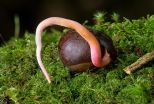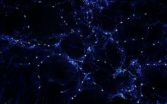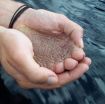INFORMATION:
Seed dormancy, a property that prevents germination, already existed 360 million years ago
Seed dormancy is a phenomenon that has intrigued naturalists for decades,
2014-11-19
(Press-News.org) An international team of scientists, coordinated by a researcher from the U. of Granada, has found that seed dormancy (a property that prevents germination under non-favourable conditions) was a feature already present in the first seeds, 360 million years ago.
Seed dormancy is a phenomenon that has intrigued naturalists for decades, since it conditions the dynamics of natural vegetation and agricultural cycles. There are several types of dormancy, and some of them are modulated by environmental conditions in more subtle ways than others.
In an article published in the New Phytologist journal, these scientists have studied the evolution of dormancy in seeds using a unique data group. This included the features of dormancy in more than 14.000 species. It is the result of Carol and Jerry Baskin's work, the co-authors of this publication, who have been studying latency since the 60s.
The analyses conducted by this team of researchers have established that dormancy is as old as seeds themselves. In other words, the oldest among all seeds already had dormancy. 'Of all possible types of dormancy, the oldest one already featured very sophisticated adjustments to environmental conditions", according to the coordinator of this project, Rafael Rubio de Casas, a researcher from the Environment Department at the University of Granada, and the only Spaniard involved in this research.
Producing new species
The results of this project indicate that plants without dormancy tend to be less capable of diversification, i.e. to produce new species. "This can be due to the fact that dormancy facilitates that germination only takes place at the optimal moment, in spite of changes in the environment, due either to weather phenomena, or whether due to the fact that the seeds reach a new location after dispersal. This adjustment of the plant cycle to the new environment can reduce the probability of a particular species to become extinct", Rubio de Casas pointed out.
Dormancy does not simply involve that seeds do not germinate when it is too hot or too cold, since under those conditions it is the environment itself which precludes germination. "What dormancy does is make sure that the seeds do not germinate even when conditions are favourable, which precludes germination after a summer storm, or during a few warm days in winter", the U. of Granada researcher added.
However, not all plants have dormant seeds. Actually, many species of plants simply germinate at the moment when their seeds are exposed to favourable conditions. Besides, it appears that plants can acquire and lose the dormancy of their seeds in a relatively fast way as a result of natural selection.
"For instance, in the case of cultivated plants, dormancy is one of the first features that appear to have been lost over the domestication process, and for this reason the date for sowing is such an important parameter in farming", according to Rubio de Casas.
ELSE PRESS RELEASES FROM THIS DATE:
Spooky alignment of quasars across billions of light-years
2014-11-19
Quasars are galaxies with very active supermassive black holes at their centres. These black holes are surrounded by spinning discs of extremely hot material that is often spewed out in long jets along their axes of rotation. Quasars can shine more brightly than all the stars in the rest of their host galaxies put together.
A team led by Damien Hutsemékers from the University of Liège in Belgium used the FORS instrument on the VLT to study 93 quasars that were known to form huge groupings spread over billions of light-years, seen at a time when the Universe ...
Many older brains have plasticity, but in a different place
2014-11-19
PROVIDENCE, R.I. [Brown University] -- A widely presumed problem of aging is that the brain becomes less flexible -- less plastic -- and that learning may therefore become more difficult. A new study led by Brown University researchers contradicts that notion with a finding that plasticity did occur in seniors who learned a task well, but it occurred in a different part of the brain than in younger people.
When many older subjects learned a new visual task, the researchers found, they unexpectedly showed a significantly associated change in the white matter of the brain. ...
Mind the gap -- how new insight into cells could lead to better drugs
2014-11-19
Professor Dan Davis and his team at the Manchester Collaborative Centre for Inflammation Research, working in collaboration with global healthcare company GSK, investigated how different types of immune cells communicate with each other - and how they kill cancerous or infected cells. Their research has been published in Nature Communications.
Professor Davis says: "We studied the immune system and then stumbled across something that may explain why some drugs don't work as well as hoped. We found that immune cells secrete molecules to other cells across a very small ...
When it comes to teen alcohol use, close friends have more influence than peers
2014-11-19
A recent study by an Indiana University researcher has found that adolescents' alcohol use is influenced by their close friends' use, regardless of how much alcohol they think their general peers consume.
Jonathon Beckmeyer, assistant professor in the Department of Applied Health Science at the IU School of Public Health-Bloomington and author of the study, said his research generally focuses on the onset of teen alcohol use and how their social relationships shape those experiences.
"We've known for a long time that friends and peers have an influence on individual ...
Ancient genetic program employed in more than just fins and limbs
2014-11-19
SAN FRANCISCO, Nov. 19, 2014 -- Hox genes are master body-building genes that specify where an animal's head, tail and everything in between should go. There's even a special Hox gene program that directs the development of limbs and fins, including specific modifications such as the thumb in mice and humans. Now, San Francisco State University researchers show that this fin- and limb-building genetic program is also utilized during the development of other vertebrate features.
The discovery means this ancient genetic program is employed in a variety of features beyond ...
A medium amount of physical activity can lower the risk of Parkinson's disease
2014-11-19
A new study, published online in Brain: A Journal of Neurology today, followed 43,368 individuals in Sweden for an average of 12.6 years to examine the impact of physical activity on Parkinson's disease risk. It was found that "a medium amount" of physical activity lowers the risk of Parkinson's disease.
Karin Wirdefeldt of the Karolinska Institutet in Stockholm and her colleagues used the Swedish National March Cohort to analyse comprehensive information on physical activity of all kinds. They assessed household and commuting activity, occupational activity, leisure ...
Peanut in household dust linked to peanut allergy in children with eczema during infancy
2014-11-19
A new study led by researchers at King's College London in collaboration with the US Consortium of Food Allergy Research and the University of Dundee has found a strong link between environmental exposure to peanut protein during infancy (measured in household dust) and an allergic response to peanuts in children who have eczema early in life.
Around two per cent of school children in the UK and the US are allergic to peanuts. Severe eczema in early infancy has been linked to food allergies, particularly peanut allergy.
The study, published in the Journal of Allergy ...
Calcium loss turning lakes to 'jelly'
2014-11-19
New research on a number of Canadian lakes show that historical acid deposits as a result of industry have greatly reduced calcium levels in the water - dramatically impacting populations of calcium-rich plankton such as Daphnia water fleas that dominate these ecosystems.
Falling calcium levels mean Daphnia cannot get the nutrients they need to survive and reproduce, and are consequently consuming less food and becoming more susceptible to predators, leaving more algae for other organisms to feed on.
This has left a small jelly-clad organism called Holopedium to take ...
High incidence of bowel disease seen in people with lung conditions
2014-11-19
People with airway diseases, including asthma and chronic obstructive pulmonary disease (COPD), have a higher incidence of inflammatory bowel disease, such as Crohn's disease and ulcerative colitis, according to the findings of a new study.
The research, which is published online today (19 November 2014) in the European Respiratory Journal, is the first population-based study to examine the association between airway diseases and the incidence of bowel disease. The news comes on World COPD Day, which aims to improve awareness and care of COPD.
The results showed that ...
Clean energy 'bio batteries' a step closer
2014-11-19
Researchers from the University of East Anglia (UEA) are a step closer to enhancing the generation of clean energy from bacteria.
A report published today shows how electrons hop across otherwise electrically insulating areas of bacterial proteins, and that the rate of electrical transfer is dependent on the orientation and proximity of electrically conductive 'stepping stones'.
It is hoped that this natural process can be used to improve 'bio batteries' which could produce energy for portable technology such as mobile phones, tablets and laptops - powered by human ...
LAST 30 PRESS RELEASES:
Making lighter work of calculating fluid and heat flow
Normalizing blood sugar can halve heart attack risk
Lowering blood sugar cuts heart attack risk in people with prediabetes
Study links genetic variants to risk of blinding eye disease in premature infants
Non-opioid ‘pain sponge’ therapy halts cartilage degeneration and relieves chronic pain
AI can pick up cultural values by mimicking how kids learn
China’s ecological redlines offer fast track to 30 x 30 global conservation goal
Invisible indoor threats: emerging household contaminants and their growing risks to human health
Adding antibody treatment to chemo boosts outcomes for children with rare cancer
Germline pathogenic variants among women without a history of breast cancer
Tanning beds triple melanoma risk, potentially causing broad DNA damage
Unique bond identified as key to viral infection speed
Indoor tanning makes youthful skin much older on a genetic level
Mouse model sheds new light on the causes and potential solutions to human GI problems linked to muscular dystrophy
The Journal of Nuclear Medicine ahead-of-print tip sheet: December 12, 2025
Smarter tools for peering into the microscopic world
Applications open for funding to conduct research in the Kinsey Institute archives
Global measure underestimates the severity of food insecurity
Child survivors of critical illness are missing out on timely follow up care
Risk-based vs annual breast cancer screening / the WISDOM randomized clinical trial
University of Toronto launches Electric Vehicle Innovation Ontario to accelerate advanced EV technologies and build Canada’s innovation advantage
Early relapse predicts poor outcomes in aggressive blood cancer
American College of Lifestyle Medicine applauds two CMS models aligned with lifestyle medicine practice and reimbursement
Clinical trial finds cannabis use not a barrier to quitting nicotine vaping
Supplemental nutrition assistance program policies and food insecurity
Switching immune cells to “night mode” could limit damage after a heart attack, study suggests
URI-based Global RIghts Project report spotlights continued troubling trends in worldwide inhumane treatment
Neutrophils are less aggressive at night, explaining why nighttime heart attacks cause less damage than daytime events
Menopausal hormone therapy may not pose breast cancer risk for women with BRCA mutations
Mobile health tool may improve quality of life for adolescent and young adult breast cancer survivors
[Press-News.org] Seed dormancy, a property that prevents germination, already existed 360 million years agoSeed dormancy is a phenomenon that has intrigued naturalists for decades,




